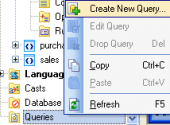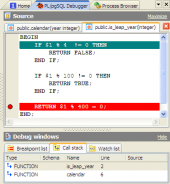PostgreSQL Maestro online Help
| Prev | Return to chapter overview | Next |
Editing role properties
Role Editor provides you with an ability to edit role properties and membership. The detailed description is given below.
Members
Specify here one or more existing roles which are automatically added as members of the new role. Admin option gives to the role the right to grant membership in this role to others.
Member of
The tab lists one or more existing roles to which the new role will be immediately added as a new member.
Variables
The tab is implemented to view and edit this role's session defaults for the specified configuration parameters to the given value.
Name
Edit the role name within the field. To do it more quickly use the Rename Role link of pop-up menu in the explorer tree.
Can Login
The checkbox determines whether a role is allowed to log in; that is, whether the role can be given as the initial session authorization name during client connection. A role having with the option checked can be thought of as a user. Roles without this attribute are useful for managing database privileges, but are not users in the usual sense of the word.
Inherits rights from parent roles
The clause determines whether a role "inherits" the privileges of roles it is a member of. A role with the option checked can automatically use whatever database privileges have been granted to all roles it is directly or indirectly a member of. Otherwise, membership in another role only grants the ability to set role to that other role; the privileges of the other role are only available after having done so.
Connection limit (-1 for no limit)
The field value specifies how many concurrent connections the role can make. -1 (the default) means no limit.
Valid until
The field contains an absolute time after which the role's password is no longer valid. If this clause is omitted the password will be valid for all time.
Can Create Users (Superuser)
This clause determines whether the new role is a "superuser", who can override all access restrictions within the database.
Can create databases
The option defines a user's ability to create databases. If it is specified, the role being defined will be allowed to create his own databases. Set false to deny the role the ability to create databases.
Can create roles
Use the checkbox to define a role's ability to create databases. If the option is specified, the role being defined will be allowed to create new databases. Specifying the opposite will deny a role the ability to create databases.
Can update system catalog directly
Use System ID to specify the PostgreSQL role ID of the new role. This is normally not necessary, but may be useful if you need to recreate the owner of an orphaned object. If this is not specified, the highest assigned role ID plus one (with a minimum of 100) will be used as default.
Password
Use the field to edit the role's password. If you do not plan to use password authentication you can omit this option, but then the role will not be able to connect if you decide to switch to password authentication.
Password Encrypted
This Checkbox allows you to control whether the password is stored encrypted in the system catalogs.
| Prev | Return to chapter overview | Next |





 Download
Download Buy
Buy
